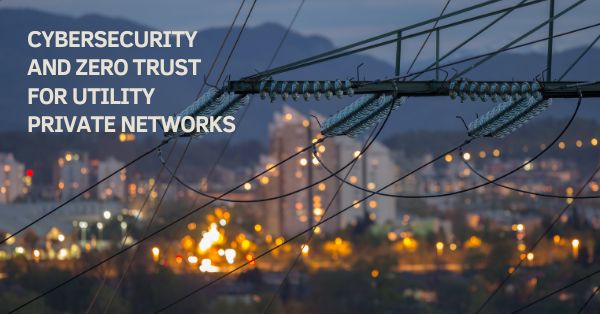As utilities continue to modernize their operations using private LTE and 5G networks, cybersecurity has become a top priority. These networks are increasingly mission-critical, supporting real-time grid control, SCADA systems, distributed energy integration, and mobile workforce enablement. A single breach or failure could result in outages, safety risks, or even national security implications. This reality has pushed cybersecurity from an IT afterthought to a core design principle.
In this ninth installment of the Connected Utilities series, we examine the cybersecurity imperatives for utility private networks and how Zero Trust Architecture (ZTA) principles are being implemented to protect critical infrastructure.
Evolving Cyber Threats Facing Utility Private Networks
Utilities are attractive targets for cyberattacks due to the essential nature of their services. Threat actors include nation-states, cybercriminal groups, and even insider threats. The convergence of IT and OT systems introduces new vulnerabilities, especially as more devices connect to the grid edge. Common threats include:
- Ransomware targeting SCADA systems or operations centers
- Supply chain attacks via network components or software
- Unauthorized access to remote substations or field devices
- Data exfiltration or tampering with operational telemetry
- Distributed Denial-of-Service (DDoS) attacks targeting utility web and edge services
Cybersecurity incidents have evolved beyond singular events—they now operate as ongoing campaigns. Persistent threats may involve long dwell times, during which attackers silently monitor network activity, map control flows, and identify lateral pathways to sensitive assets. With utilities adopting more cloud-native, virtualized, and edge-based architectures, the traditional perimeter-based model of security becomes increasingly inadequate. This is where Zero Trust principles come into play.
Implementing Zero Trust for Utility Private Networks
Zero Trust assumes no device, user, or service is inherently trustworthy, even inside the network. In utility environments, this approach is gaining traction for its ability to enforce granular access controls, detect anomalies in real time, and reduce lateral movement of attackers.
Key elements of Zero Trust implementation include:
- Micro-segmentation: Dividing the network into isolated zones with restricted interconnectivity.
- Continuous Authentication: Verifying identity and device posture at every point of interaction.
- Policy-Based Access: Granting access dynamically based on user role, location, time, and device state.
- Encrypted Traffic: Ensuring all communication between edge devices, controllers, and cloud cores is encrypted.
- Anomaly Detection and Threat Response: Using AI and ML models to spot unusual behaviors and trigger alerts or automated mitigations.
- Device Trust Scoring: Continuously evaluating the risk profile of connected assets and flagging non-compliant or compromised nodes.
Zero Trust is not a one-size-fits-all approach. Utilities are adapting these principles to their hybrid environments by layering Zero Trust policies into existing NERC CIP frameworks or IEC 62443 controls. Implementation often begins with crown-jewel systems (e.g., SCADA or DER controllers) and gradually extends across operational tiers. The emphasis is on containment and fast remediation, not just prevention.
Cybersecurity Compliance Checklist for Utility Private Networks
To ensure private networks meet cybersecurity best practices and regulatory requirements, utilities can follow the checklist below:
| Compliance Area | Key Requirements |
|---|---|
| Identity & Access Control | Role-based access, MFA, and secure provisioning of devices |
| Network Segmentation | Micro-segmentation by site, application, and function |
| Encryption & Data Security | End-to-end encryption, key management, and data retention policies |
| Threat Detection & Response | AI-based monitoring, incident playbooks, and intrusion detection systems |
| Change Management | Version control, rollback capabilities, and real-time audit logging |
| Supply Chain Risk | Vendor assessments, firmware validation, and tamper-resistant hardware |
| Governance & Oversight | Internal controls, regulatory alignment (e.g., NERC CIP, ISO/IEC 27001, NIST 800-53) |
This checklist can also serve as an internal audit tool and framework for vendor qualification.
Securing Utility Private Networks at Every Lifecycle Stage
Cybersecurity is not a one-time effort. From the initial design of a private network through its operational lifecycle, utilities must build in protections at each stage:
- Design Phase: Include secure architecture principles, risk modeling, and Zero Trust planning.
- Deployment Phase: Validate components, test security protocols, and perform penetration testing.
- Operations Phase: Monitor for threats, patch systems regularly, and conduct red team exercises.
- Scaling Phase: Reassess policies and extend segmentation as more devices, users, and partners are added.
Utilities are also adopting tools like software-defined perimeters (SDP), network policy automation, and digital twin simulations to continuously validate the integrity of their network operations. These efforts help close visibility gaps between IT and OT, improving response speed and reducing recovery costs in the event of a breach.
Building a Culture of Cyber Resilience in Utilities
Beyond tools and technologies, cybersecurity in private networks requires cultural change. Utilities must embed cyber awareness into operations, from field crews to network architects. This includes:
- Regular training and simulations
- Clear escalation paths for incidents
- Cross-functional collaboration between IT, OT, and cybersecurity teams
- Inclusion of cyber risk in all network design and procurement decisions
- Creation of Security Operations Centers (SOCs) tailored to hybrid IT/OT environments
Utilities that treat cybersecurity as a shared operational responsibility are more likely to build resilient, adaptable networks that can withstand evolving threats. Cybersecurity should also extend to business continuity planning, ensuring that in the event of a successful attack, critical systems can fail gracefully and be restored rapidly.
Why Cybersecurity and Zero Trust Are Essential for Utilities
Private networks represent not just a new infrastructure layer, but a new security perimeter. Utilities that invest in Zero Trust principles, compliance frameworks, and cyber-aware operations will be best positioned to protect their assets and communities. As utility private networks evolve into multi-tenant platforms with monetization potential, secure design becomes not only a safeguard but a competitive advantage.
By establishing cybersecurity as a continuous practice—one that is tested, reviewed, and aligned with utility mission goals—operators can navigate a future defined by both technological progress and increasingly complex threat vectors.
In the final blog in this Connected Utilities series, we’ll explore the future roadmap, examining how 5G Advanced and AI-driven architectures are reshaping what’s next for connected utility operations.
Explore More from the Connected Utilities Series
Continue your learning journey with our full Connected Utilities blog series:
- Why Utilities Are Investing in Private Networks to Power the Digital Grid
- Strategic Use Cases for Private Networks in the Utility Sector
- Trends Accelerating Private Network Adoption in the Utility Sector
- Deployment Architectures and Spectrum Strategies for Utility Private Networks
- Edge Computing and AI for Predictive Utility Operations
- Governance and Lifecycle Management of Utility Private Networks
- Partner Ecosystems for Scaling Utility Private Networks
- Sustainability and ESG Drivers for Private Networks
- Monetization and Shared Use Models for Utility Private Networks
- Cybersecurity and Zero Trust for Utility Private Networks
- Future Roadmap – 5G Advanced and the AI-Driven Grid
Strengthen Your Utility Private Network Strategy
Assess your grid’s 5G readiness with our industry-specific tool, uncover gaps, and get clear, executive-ready insights to plan and deploy with confidence. Check Readiness & Premium Plans








































